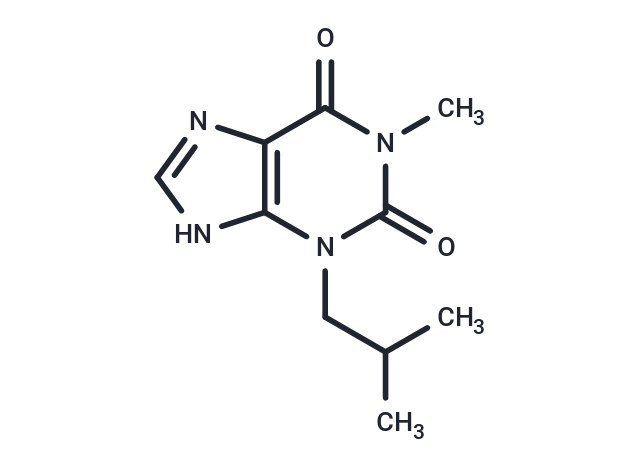Shopping Cart
Remove All Your shopping cart is currently empty
Your shopping cart is currently empty
IBMX (Methylisobutylxanthine) is a broad-spectrum phosphodiesterase (PDE) inhibitor with inhibitory activity against PDE3, PDE4, and PDE5 (IC50=6.5/26.3/31.7 μM). IBMX enhances the intracellular cAMP level.

| Pack Size | Price | USA Warehouse | Global Warehouse | Quantity |
|---|---|---|---|---|
| 25 mg | $33 | In Stock | In Stock | |
| 50 mg | $47 | - | In Stock | |
| 100 mg | $58 | - | In Stock | |
| 200 mg | $105 | - | In Stock | |
| 1 mL x 10 mM (in DMSO) | $50 | In Stock | In Stock |
| Description | IBMX (Methylisobutylxanthine) is a broad-spectrum phosphodiesterase (PDE) inhibitor with inhibitory activity against PDE3, PDE4, and PDE5 (IC50=6.5/26.3/31.7 μM). IBMX enhances the intracellular cAMP level. |
| Targets&IC50 | THIK-1:120 μM, PDE3:6.5 μM, PDE4:26.3 μM, PDE5:31.7 μM |
| In vitro | METHODS: CCDs isolated from HK-fed rats were pretreated with IBMX (100 μM) for 20 min and examined the effect of ANG II or cGMP on channel activity. RESULTS: IBMX activated ROMK channels and prevented further channel activation by ANG II. [1] METHODS: Primary cultures of guinea pig TSMC were assayed for the effect of KMUP-1 on cAMP and cGMP levels in the presence of IBMX (100 μM). RESULTS: IBMX and KMUP-1 significantly increased cAMP and cGMP levels. The effect of KMUP-1 alone on cAMP and cGMP levels was not significantly different from that in the presence of IBMX. [2] METHODS: Mammalian cell CHO was treated with IBMX (10-1000 μM) and whole cell currents were measured using the membrane clamp technique. RESULTS: A steady-state dose-response curve for the effect of IBMX on THIK-1 currents could be fitted with a Hill coefficient of 1 and an IC50 of 120 μM.[3] |
| In vivo | METHODS: To test the metabolic effects on mice, IBMX (1 mg/kg) was injected subcutaneously into mice twice daily for seven days. RESULTS: IBMX significantly increased blood glucose levels in mice (blood glucose, mg/dl, control=141, IBMX=210). [4] METHODS: To test the metabolic effects on hyperglycemic mice, glucose (0.5 g/kg) and IBMX (1 mg/kg) were injected i.v. in femoral veins into Wistar rats. RESULTS: In hyperglycemic rats, IBMX lowered blood glucose, IBMX did not change plasma insulin levels, and IBMX decreased hepatic glycogen stores. [4] |
| Cell Research | Intracellular cyclic GMP and cyclic AMP concentrations in guinea-pig TSMCs were assayed as previously described. In brief, cells were grown in 24-well plates 10^5 cells per well. At confluence, monolayer cells were washed with phosphate buffer solution (PBS) and then incubated with KMUP-1 (0.1–100 μM) in the presence of 100 μM IBMX for 20 min. Incubation was terminated by the addition of 10% trichloroacetic acid (TCA). Cell suspensions were sonicated and then centrifuged at 2500 × g for 15 min at 4°C. To remove TCA, the supernatants were extracted three times with 5 volumes of water-saturated diethyl ether. Then, the supernatants were lyophilized and the cyclic GMP or AMP of each sample was determined by using commercially available radioimmunoassay kits [1]. |
| Animal Research | Male mice (25-35 g), obtained from the animal house of Faculty of Medicine, were kept in controlled environmental conditions (temperature: 23±2 oC; light-dark cycle: 7 a.m. to 7 p.m.) and were divided randomly into groups of seven. All test compounds were dissolved in DMSO and diluted to desired concentration with less than 1% DMSO. For the experiment, the test compound (IBMX, milrinone, MCPIP, mc1, mc2, mc5 or mc6) or solvent (control) was injected subcutaneously to mice at 1 mg/kg dosage twice a day (8:00 a.m. and 8:00 p.m.) for 7 days. On day 8, animals were anesthetized with intraperitoneal injection of thiopental (80 mg/kg) and blood samples were obtained from their hearts and then the liver was dissected. Each sample was centrifuged for 5 min and its serum was separated [3]. |
| Synonyms | Methylisobutylxanthine, Isobutylmethylxanthine, 3-Isobutyl-1-methylxanthine, 1-Methyl-3-Isobutylxanthine |
| Molecular Weight | 222.24 |
| Formula | C10H14N4O2 |
| Cas No. | 28822-58-4 |
| Smiles | CC(C)Cn1c2[nH]cnc2c(=O)n(C)c1=O |
| Relative Density. | 1.2042 g/cm3 (Estimated) |
| Color | White |
| Appearance | Solid |
| Storage | store at low temperature | Powder: -20°C for 3 years | In solvent: -80°C for 1 year | Shipping with blue ice/Shipping at ambient temperature. | ||||||||||||||||||||||||||||||||||||||||
| Solubility Information | H2O: 2.23 mg/mL (10.03 mM), Sonication is recommended. DMSO: 250 mg/mL (1124.91 mM), Sonication is recommended. Ethanol: 22.24 mg/mL (100.07 mM), Sonication is recommended. | ||||||||||||||||||||||||||||||||||||||||
| In Vivo Formulation | 10% DMSO+90% Saline: 1.67 mg/mL (7.51 mM), Solution. Please add the solvents sequentially, clarifying the solution as much as possible before adding the next one. Dissolve by heating and/or sonication if necessary. Working solution is recommended to be prepared and used immediately. The formulation provided above is for reference purposes only. In vivo formulations may vary and should be modified based on specific experimental conditions. | ||||||||||||||||||||||||||||||||||||||||
Solution Preparation Table | |||||||||||||||||||||||||||||||||||||||||
H2O/Ethanol/DMSO
Ethanol/DMSO
| |||||||||||||||||||||||||||||||||||||||||
| Size | Quantity | Unit Price | Amount | Operation |
|---|

Copyright © 2015-2025 TargetMol Chemicals Inc. All Rights Reserved.